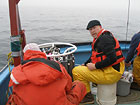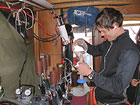

 | |||||||||||||||||
|
|
Journals 2005/2006Jeff Manker
August 20, 2005 After breakfast at BASC we headed to the anchorage in Elson Lagoon. On board the scientists ironed out some problems with the instruments (I am a little out of the loop as they struggle to get complex programs to mesh with input of data). I want to help but have no experience with any of this and try very hard to stay out of the way and be useful at the same time. I have been talking with the captain (Bill Kopplin) and Alternate Captain (Ned Manning) and helping with the odd task.
The R/V Annika Marie is a forty-three foot research vessel. On board are the two crew (mentioned above), the two PI's, Carin Ashjian from WHOI (Woods Hole Oceanographic Institution) and Bob Campbell from University of Rhode Island, Graduate School of Oceanography, Steve Okkonen, from University of Alaska, Fairbanks, Phil Alatalo also from WHOI, Aaron Hartz, a graduate student from Oregon State University and myself. The boat is small (the main cabin maybe only 150 square feet) for so many people, but I have to admire how these people passionately go about their science. They stand and sit hip to hip doggedly pursuing the solution to the glitches that seem to spring up one after another. They are determined to produce some usable data in this very short season at the top of the world. We had a long day today on the boat as we ran our first transect, starting about noon. After about an hour run to get out of the lagoon we put the ADCP and the Acrobat into the water and headed off to the northwest in a straight line for about 5 miles. Along the way I found something to do as a bird and mammal observer, recording any sightings along the way. Meanwhile, for the next hour or so the instruments collected data while the scientists watched the compiling data on the array of computers. When we came to the end of our line, we stopped and retrieved the instruments and switched them for the CTD rosette, which was lowered twice (once to locate plankton concentrations and the second time to trigger the Niskin bottles in relation to those plankton concentrations). When it came back up we quickly switched the cable over to the VPR and deployed it over the transom. Meanwhile I assisted Aaron in collecting the samples from the Niskin bottles.
Every collecting bottle and tube had to be flushed with seawater to avoid contamination. Samples were placed in two different types of containers: one-liter bottles that would be filtered and smaller bottles that were placed into the freezer. Once the VPR had been to the bottom and back we lifted it back on board and headed for home.
Aaron went to work setting up a complex filtering apparatus that used a vacuum pump to essentially suck the water through a filter paper that separated the organisms and nutrient material from the seawater. These were brought back to the lab for later examination. |
||||||||||||||||




